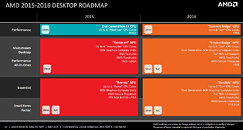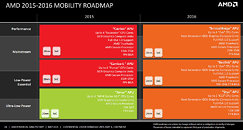Thursday, April 30th 2015

AMD Zen-based 8-core Desktop CPU Arrives in 2016, on Socket FM3
In what is a confirmation that AMD has killed socket AM3+ and its 3-chip platform, a leaked slide that's part of a larger press-deck addressing investors, tells us that the company is planning to launch a high-performance desktop processor targeting enthusiasts, based on its next-generation "Zen" architecture, in 2016. Our older articles detail the Zen CPU core design, and the way in which AMD will build multi-core CPUs with it. This processor will be codenamed "Summit Ridge," and will be a CPU, and not an APU as previously reported. In AMD-speak, what sets a CPU apart from an APU is its lack of integrated graphics.
AMD "Summit Ridge" will be an 8-core CPU built on the 14 nanometer silicon fab process. It will feature eight "Zen" cores, with 512 KB of L2 cache per core, 16 MB of L3 cache, with 8 MB shared between two sets of four cores, each; a dual-channel integrated memory controller that likely supports both DDR3 and DDR4 memory types; and an integrated PCI-Express gen 3.0 root complex, with a total of 22 lanes. We can deduce this from the fact that "Summit Ridge" will be built in the same upcoming socket FM3 package, which the company's "Bristol Ridge" Zen-based APU will be built on. "Summit Ridge" will hence be more competitive with Intel's 6th generation Core "Skylake" processors, such as the i7-6700K and i5-6600K, than the company's "Broadwell-E" HEDT platform.The mainstream APU based on Zen, codenamed "Bristol Ridge," features four Zen cores, 512 KB of L2 cache, 8 MB of shared L3 cache, an integrated GPU based on AMD's "Greenland" class stream processors, and a similar uncore loadout as "Summit Ridge."
AMD "Summit Ridge" will be an 8-core CPU built on the 14 nanometer silicon fab process. It will feature eight "Zen" cores, with 512 KB of L2 cache per core, 16 MB of L3 cache, with 8 MB shared between two sets of four cores, each; a dual-channel integrated memory controller that likely supports both DDR3 and DDR4 memory types; and an integrated PCI-Express gen 3.0 root complex, with a total of 22 lanes. We can deduce this from the fact that "Summit Ridge" will be built in the same upcoming socket FM3 package, which the company's "Bristol Ridge" Zen-based APU will be built on. "Summit Ridge" will hence be more competitive with Intel's 6th generation Core "Skylake" processors, such as the i7-6700K and i5-6600K, than the company's "Broadwell-E" HEDT platform.The mainstream APU based on Zen, codenamed "Bristol Ridge," features four Zen cores, 512 KB of L2 cache, 8 MB of shared L3 cache, an integrated GPU based on AMD's "Greenland" class stream processors, and a similar uncore loadout as "Summit Ridge."


73 Comments on AMD Zen-based 8-core Desktop CPU Arrives in 2016, on Socket FM3
1: Whats the TDP of this chip
2: What kind of changes can we plan for FM3 (Power Phase design, power draw, feature set, etc)
3: Are they really totally killing AM3+ and are they now killing AM1?
I mean if they are making FM3 the main board for them that is perfectly fine, however currently FM2+ is a limited platform in many areas and it just begs the question how much more serious can they make the platform overall. Its a bit odd honestly but probably necessary since they are getting quite tight on their budget constrains and hard to manage multiple types of chipsets. Ill be following it very fondly and curiously but I am interested in what this could all mean for the platform!
2-PCIe 3.0, usb3.1
3-AM3 is gone. AM1 is for totally different product range and will stay.
AMD will do a good job on socket FM3.
I really get the feeling Zen is going to be essentially Broadwell without terrible scaling issues; or essentially clock similar or even higher compared to skylake but without the arch/ipc improvements (and ditching the built-in graphics should allow them some space to clock cpus higher in a similar tdp). One would think this would be something like 2x65w (140w) chips on a package, but who knows.
In a world where Broadwell didn't *appear* to be an enthusiast IPC/single-threaded disaster (made up for on the desktop through gpu upgrades almost nobody cares about), it would be interesting to see 8-core parts battle it out at similar clocks (4.2ghz?). As it sits though, one has to wonder if wonder if Intel will bring something like 2-4 extra cores at a lower clock to the enthusiast fight, while AMD could bring a higher core clock on the 'midrange' desktop to play against Skylake.
I could be totally wrong, but I envision them doing something like set tdp aims for both chips and mcm packages (ex: 35w, 65w, 95w, CPU; 30w, 60-65w, 70-75w etc gpu) and then mixing/matching it with either a single cpu chip, two cpu chips, or one cpu + greenland gpu clocked in different configurations (ex: 65w/95w/140w etc)...but it's also conceivable they could be arbitrary and very much dictated by whatever it takes to match/beat Intel (or even a low-end nvidia gpu) in whatever metric a certain product is aimed (or is the most efficient mix hence showing them in their best light).
It surely will be interesting to see how this all develops...but I think such a slotted approach (especially from a binning perspective) would make sense, as well as could explain why one such apu is rumored to have an extravagant tdp...It could essentially be the 'top bin' of both cpu + gpu chips (ex: 95w cpu + 75w gpu).
In fact if I didn't reply everyone would be happy to let that comment get buried.
Very Excite.
They will have one socket to work with. The rest is up to AMD
AM1 hasn't been left out of anything. It's an ultra-low cost platform with features sufficient for its purpose. It's not a luxury or performance platform.
It is quite a legitimate concern that the platform will ultimately be tripped up by not having any decent micro atx boards. or mini itx, for that matter. many people don't want or need full atx, and limiting to full atx is leaving any micro or mini itx game rig to intel.
And not sure if would work, but AMD should look into quality of these boards and run some kind of control on them.You mean to say Intel don't have boost clock feature?
Correct me if I am wrong.
:toast:
Leaks say the hottest Summit Ridge will be 95w (saw a leak but can't remember where it was). Some are expecting at least a 40% improvement over Excavator in IPC. It will not beat Skylake, but it should be close enough.
Memory subsystem is going to see massive gains since AMD is changing to an inclusive cache design.
With that said, we know that AMD has reduced the size of the L2 cache per core and this can only help improve latencies. It is also now dedicated per core (or SMT pair, like Intel's CPUs.) If we also assume that AMD have overhauled their core (which they have,) and that any improvement should be significant. I also suspect that 14nm will play a roll in lowering power consumption. All in all, I'm expecting a measurable improvement with Summit Ridge.I'm having a little bit of trouble wrapping my head around how that would work. I suspect that FM3 won't be an SoC socket. However it will be like all the others with the PCI-E root complex on the CPU.
Side note: I would hate to see HyperTransport disappear, but then again, why use it when you have PCI-E 3.0.